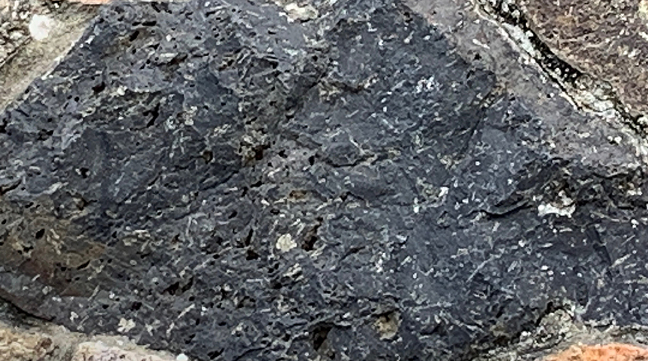Jersey Geology Trail |
Basalt. (Gk. basanos = touchstone). |
 |
Possible basaltic wall stones, partly porphyritic and vesicular, Highlands Lane, St Helier. |
| |
Basalt is a dark coloured, finely crystalline igneous rock composed of iron magnesium minerals (mafics) and plagioclase feldspar. The mafic minerals are generally Augite (pyroxene) and rarer Olivine (Mg Fe silicate) while the feldspar is normally the more calcic Labradorite. Those rich in olivine are called olivine basalts.
It forms from basic lavas which occur in mid-ocean ridge areas such as Iceland (and on the sea floor as pillow lavas called spilites with the sodic feldspar Albite instead of Labradorite) and in mid-ocean volcanoes such as those of Hawaii and Tahiti rising from the Pacific Ocean floor. In Britain, basalts form spectacular columnar jointed former flows in the Hebrides and in Northern Ireland's Giant's Causeway; while in Idaho (USA) and in the Deccan of India, as well as areas in Siberia and South America, they form vast plateaux.
In Jersey, three exposures have been recorded all of which show alteration. One is in the southern part of La Vallée des Vaux, between undifferentiated andesite and tuff, striking approximately east-west and separated from the second exposure with similar stratigraphic relationships by a fault striking north-south from Stirling Castle at the junction of Le Mont Néron and Les Grands Vaux. The third exposure is south of Rozel Manor (Bishop & Bisson, 1989, p. 22-23) about half way along the valley in St. Catherine's Woods, and occurs as a lens-shaped outcrop associated with mudstones at the base of the Rozel Conglomerate Formation. In each case they are neither extensive nor columnar jointed. The first two basalts are composed of white labradorite phenocrysts and pseudomorphs of poikilitic olivine in a purple-green, finely crystalline groundmass. For the third outcrop, the authors record that it was originally thought to be a purple amygdaloidal andesite, but was later regarded as an altered basalt (Thomas, G. M.,1977).
Basalt flows obviously seem rare in Jersey, so from their outcrop pattern could these finely crystalline basic rocks, texturally basaltic, represent minor sill-like intrusions (Whitten & Brooks, 1972, p.48) within the andesites and the Rozel Conglomerate. |
| |
|
References.
Bishop, A. C. & Bisson, G. 1989. Classical areas of British geology: Jersey: description of the 1:25,000 Channel Islands Sheet 2, (1982). (London: HMSO for the British Geological Survey).
Thomas, G. M. 1977. Volcanic rocks and their minor intrusives, eastern Jersey, Channel Islands. Unpublished PhD thesis, University of London.
Whitten, D. G. A., & Brooks, J. R. V., 1972. The Penguin Dictionary of Geology. Penguin Books. |
| |
| |
| |